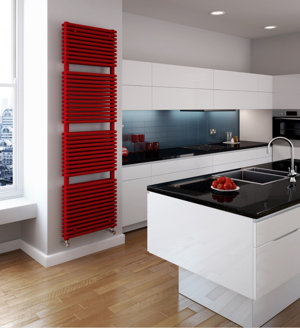Radiating success

With heating on the agenda, Chris Harvey considers the most popular form of heat delivery in homes – radiators. They have come a long way from simple designs, and now offer a wide range of choice for installers working with clients in the private and public sectors.
There is something of a quiet revolution taking place in homes across the UK. Radiators still take the responsibility for heating the vast majority of homes. Despite the popularity of underfloor heating, radiators are the emitter of choice for well over 90% of the heating systems in the UK.
One of the reasons for their continued popularity is that they have undergone development and uplift in efficient delivery of heat. Radiators manufactured prior to 2000 can be up to 50% less efficient than modern radiators, due to the increased surface area of newer radiators and the improved convection fins. Only 20% of the heat generated by a standard radiator is actually radiant heat. Around 80% is caused by convection – cool air being ‘dragged up’ behind and through the radiator in convection currents, warming the air as it flows.
Modern radiators also offer more energy efficiency because they heat up faster than older radiators, due in the main to lower water content – typically around 24% less water in modern radiators than those pre-2000. The relatively recent arrival of K3 radiators to the UK - three panels and three convection fins - has seen the potential for even greater heating and efficiency benefits from radiators with the same wall ‘footprint’.
And the very recent arrival of the first serial feed radiators in the UK has revolutionised the benefits available from radiators. These products offer 50% more radiant heat than a standard parallel feed radiator; 23% faster heat up; and 53% hotter front panel with significantly less heat loss from the back panel.
 |
| Modern radiators offer installers and clients a wide range of designs, as well as optimised heat delivery |
However, one of the important factors in delivering heat is that occupants understand and accept the technology. Whether it’s via a traditional gas boiler or a heat network, occupiers have to be willing to engage with the system in order for it to be successful. Radiators are a familiar technology, and they have the added advantage of recent developments in colour and design. Radiators being selected today are more adventurous than has previously been the case.
Whilst the standard steel panel radiators, compact designs in particular, are still best-sellers in the UK, there is an undoubted trend in the UK radiator marketplace for installers and specifiers to offer an alternative to the standard steel panel radiator in the form of a panel or decorative radiator. This can be in a new development or for refurbishment projects in the domestic or commercial sectors.
The bathroom was the first room in the home to benefit from something a bit more special, with the ladder towel rail being the first non-standard approach to heating in a home. Towel rails and specially-designed bathroom radiators tended to be tall rather than wide and the beginnings of the love affair with vertical radiators had begun. This spread kitchens where designer and decorative radiators began to appear, in particular vertical models which would take up less horizontal wall space, leaving room for kitchen units.
The days of a radiator being a purely functional heating emitter are long gone. Even a person looking to buy a radiator that is as inexpensive as possible expects the product to be aesthetically pleasing - to have rounded edges and an excellent paint finish.
But, perhaps because of the number of renovation and decorating television programmes, more people are taking an interest in their radiators. Many no longer rely solely on their heating engineer or installer to quote for “a boiler and eight rads”. They want to know whether they will be getting an attractive towel-warming radiator in the bathroom; or if they can have an attractive vertical radiator in the hallway that everyone sees as they come through the front door. They may perhaps a designer radiator in the kitchen, so anyone stopping over for something to eat sees an attractive radiator on the wall between the kitchen cabinets and the back door.
Options for installers?
So radiator manufacturers like Stelrad offer a range of radiators for every opportunity in a home or non-dwelling. The designs are a response to demand from homeowners, heating engineers and installers as well as housebuilders and architects.
And with wider availability and broader knowledge of the options available, it’s inevitable that we see the designer and decorative radiators increasingly being installed. The requirement is often for a non-standard radiator that very specifically meets the demands of the project as requested by the installer or specifier.
Chris Harvey is head of marketing for Stelrad UK.







